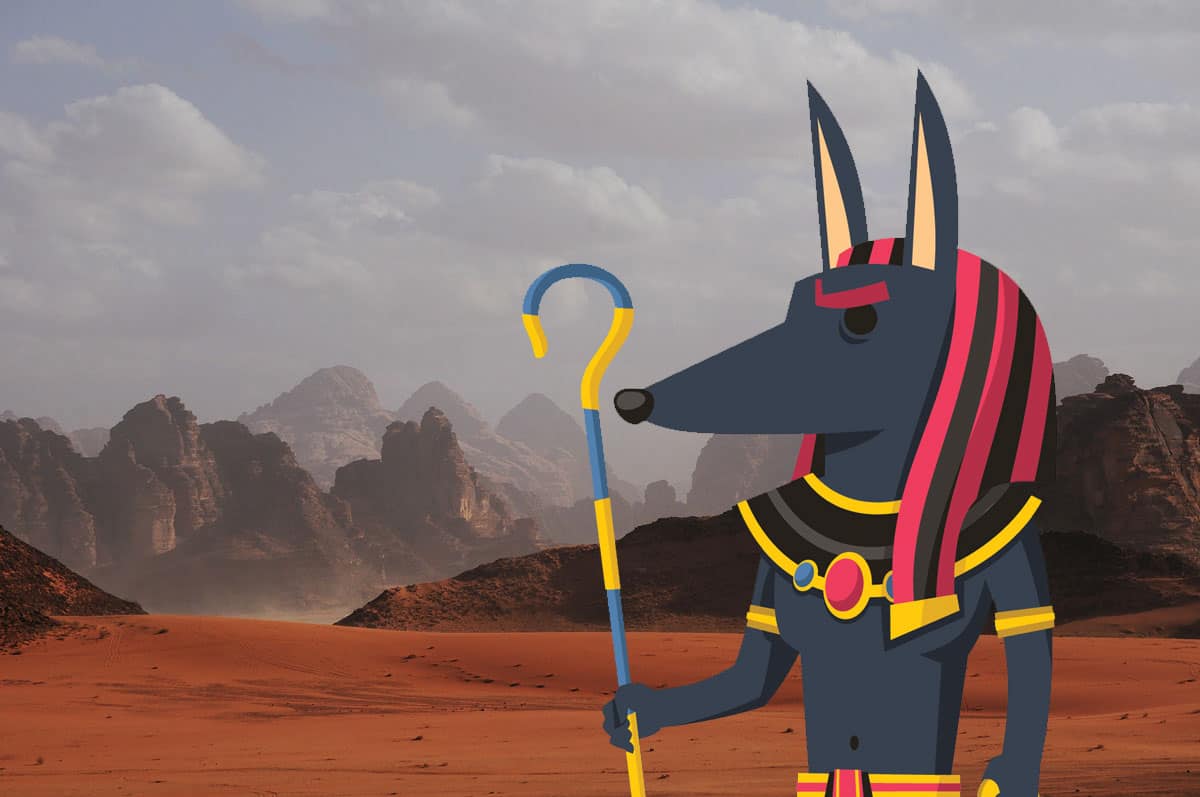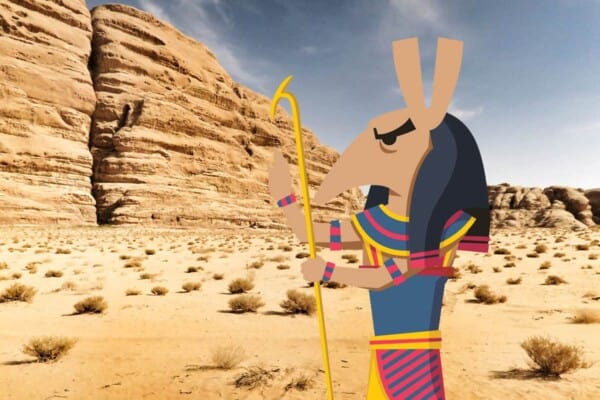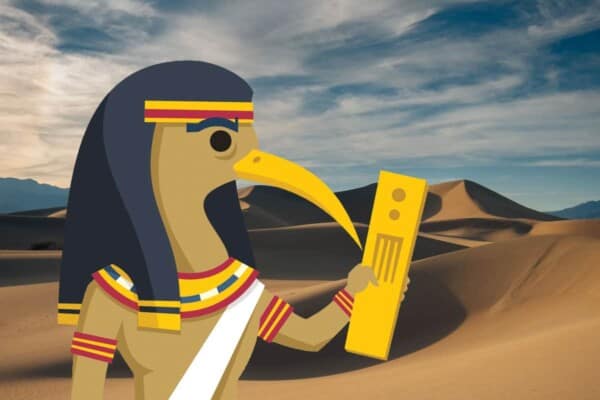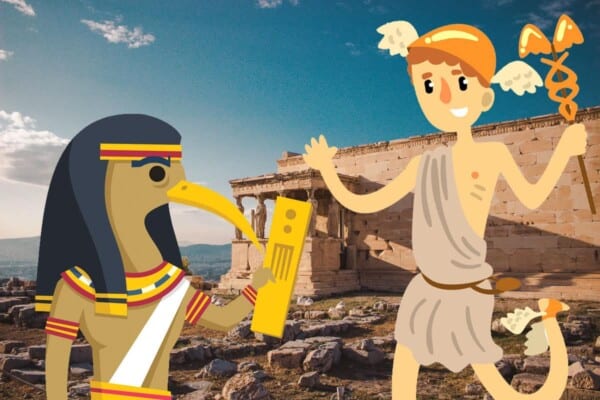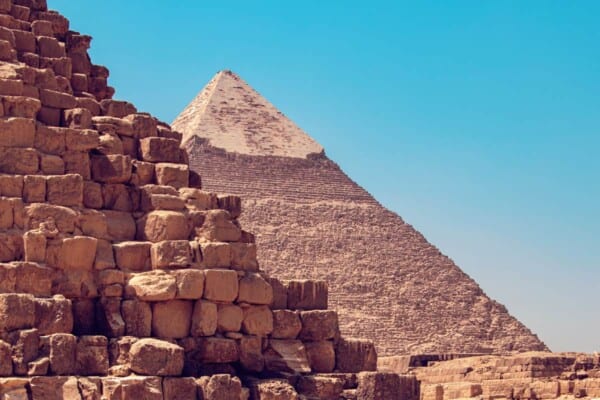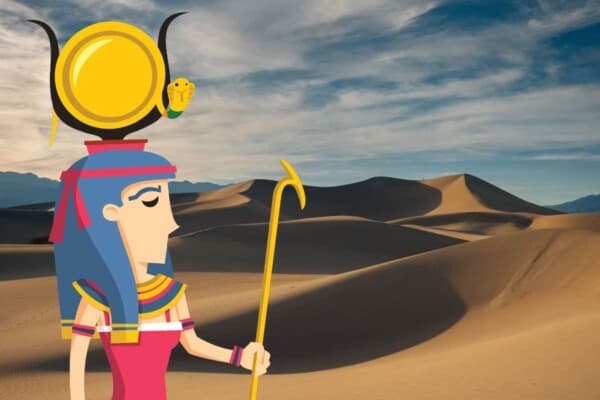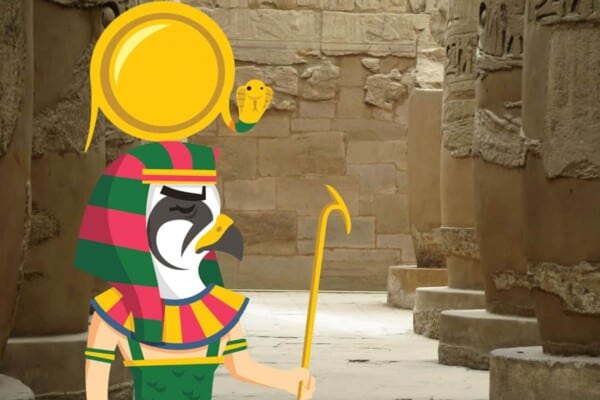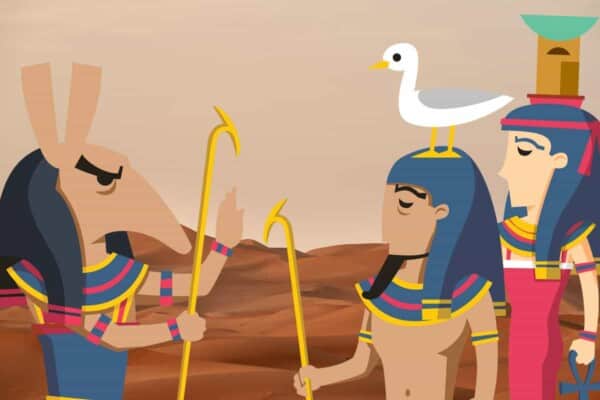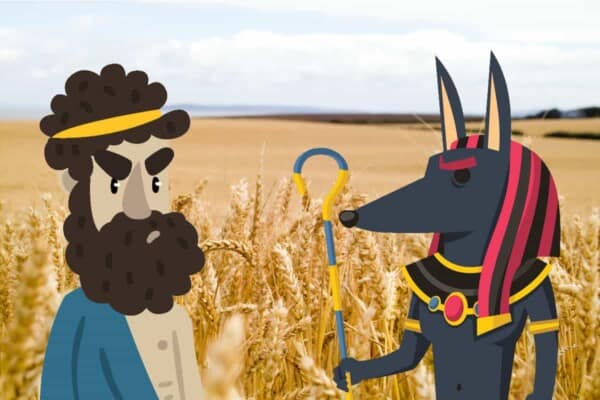Anubis, the Ancient Egyptian go of death, mummification, and many other things is very well known, but these are some fun facts you may not know. He had a dog’s head and was the son of Nephthys, the nephew of Isis, and the cousin (or brother) of Horus.
Though he is often described as jackal headed, his sacred animal was actually an African golden wolf – an animal that was referred to as a jackal until 2015! Even now, then, new facts and revelations mean we discover more and more about this ancient god of the Underworld.
25 Facts About Anubis
1. Anubis was also known as Inpu or Anpu.
The name we all know is from the Greek translation, while the other two are closer to the Egyptian and Coptic pronunciations. His original name was derived from a phrase meaning “a royal child,” and also a word meaning “to decay.”
2. Anubis had many different titles depending on his role.
Some of his titles included: Lord of the Sacred Land, He of the Sacred Mountain, The Dog Who Devours millions, Master of Secrets, The Embalmer, and The First of the Westerners.
3. He was a semi-literal guard dog.
As well as being in charge of embalming bodies to prepare them for the next life, Anubis was the guardian of tombs. He protected the mummy and the treasures with which it had been buried.
4. Anubis was associated with two different Greco-Roman gods.
Thanks to Greek and Roman occupations of Egypt, Egyptian gods were often conflated with their pantheons. As a god of the dead, Anubis was compared to Hades (Pluto). In his role as a psychopomp and servant to Osiris, though, he was more often compared to Hermes (Mercury).
5. He was one of the gods to attend the weighing of the heart ceremony.
Anubis stood by the scales of justice. If a soul passed the test, he would prepare it for the next life while Thoth recorded the decision.
6. Black and the absence of light were associated with Anubis and other mortuary gods.
Osiris was usually associated with the green of resurrection, and white represented general purity. However, black was not considered evil, just dark – like Anubis himself.
7. Wepwawet was another jackal headed god who worked in the process of death and resurrection.
After Anubis had finished his embalmment, preparation, and guiding work, the dead were passed to this other god who helped to protect them on their journey through the Underworld. A third jackal headed god, Duamutef, attended mummifications and was one of the four sons of Horus.
8. Anubis’s daughter took the form of a serpent or an ostrich.
Her name was Kebecht, Kabechet, Kebechet, or Kebhut, and she was a goddess of fresh water and purification. One of her primary duties was to assist her father in the preparation of bodies for mummification. Her mother was Anubis’s wife, Anput, the goddess of the desert and of protection.
9. Anubis’s father (or stepfather) wanted to kill him as an infant.
Anubis’s mother, Nephthys, was the sister of Osiris and Isis and married to their evil brother Set. When Nephthys bore Anubis, she feared for his life and hid him in the marshes – most likely as he was the product of an affair. Nephthys hid him in the marshes, where he was rescued and protected by Isis. He was raised by both sisters.
10. Priests o༣ften wore an Anubis mask during funerary rites.
The mask was in the shape of a black canid while leaving the priest’s human body, just as Anubis was often portrayed with a canine head.
11. Anubis was the one to embalm Osiris after he was killed by his brother Set.
Isis gathered the body of her husband and brought it to Anubis, who helped her to prepare it for the afterlife. This was what caused him to become the god of embalming, especially after Osiris was resurrected.
12. Anubis was revered in the city of Cynopolis
This city was named from the Latin cyno, derived from a Greek word that meant dog or dog-like. The city stood and primarily worshiped Anubis until the War of the High Priests during Rameses XI’s reign, during which it was destroyed. The city of Al Qeis was built upon its ruins.
13. Dead dogs were a symbol of Anubis!
As well as mummifying their beloved pets along with their bodies, some Ancient Egyptians possibly even purchased the bodies of dead dogs and puppies to use as offerings to Anubis. Some eight million dead canines have been found preserved and buried in catacombs near Cairo.
14. When combined with the Greek Hermes, Anubis took on another name.
While the two gods were sometimes seen simply as aspects of one another, they were sometimes combined into one god during the Greek occupation of Egypt. This was Hermanubis, a psychopomp, messenger, and protector of the dead. He contained aspects from both the Greek Hermes and the Egyptian Anubis.
15. A headless stuffed animal was an important fetish for Anubus.
‘Fetish’ in this case means a totem or talisman, and this fetish, called an Imuit, was sacred to Anubis as well as some other gods. The animal’s head was removed, and the body hung on a pole, and the whole thing was placed in tombs as a protective symbol. The pharaoh Tutankhamen had several golden replicas of Imuits in his final resting place.
16. Anubis was the patron god of anaesthesiology.
His intricate knowledge of the workings of the human body meant that he was a natural choice for the patron of ‘false death.’ As an embalming god, he knew how to work with a body that was unconscious without harming it to an unreasonable degree.
17. Anubis appeared in fewer myths than most other major gods but was more popular than many.
In fact, Anubis’s role as protector of the dead meant that his symbols and images were depicted everywhere in Ancient Egypt, where death and rebirth were the central tenants of their religion. Despite featuring in relatively few stories, Anubis is as well-known by westerners today as Ra, Osiris, Isis, and Set.
18. In earlier myths, Anubis was the son of Ra.
Though his father was almost always Osiris or, occasionally, Set, some earlier stories placed him as the son of the sun god. His mother, Nephthys, was sometimes replaced with the warrior cat goddess Bastet or another goddess. When Osiris gained popularity as the new god of the dead, the myths changed so that Anubis was his son, and they worked side by side.
19. Several important spells invoked Anubis’s name.
Magic spells were very important to the Ancient Egyptians, especially during funerary proceedings. During embalmment and mummification, workers would sing the praises of Anubis while pleading for him for his protection and help on behalf of the dead person.
20. Anubis was sometimes mockingly called “the Barker.”
The Greeks and the Romans found the animal-headed gods of traditional Egyptian religion pretty ridiculous. Though they ignored it for the most part when incorporating the religion with their own, the frequency of canine portrayals of Anubis meant that he became a source of mockery.
21. The most popular version of Anubis conception happened when his mother Nephthys, borrowed his aunt Isis’s husband for the night.
Stories vary on whether it was with or without Isis’s consent, but Nephthys lay with her brother Osiris one time. From that union came Anubis, the jackal-headed dog of the Underworld. Regardless of whether she had foreknowledge, Isis did not resent her sister and even helped her find and care for the child when Nephthys feared Set’s retribution. Set is sometimes said to be Anubis’s true father, however.
22. He had an army of demon messengers.
Though Anubis was not evil, his messengers would swiftly punish anyone who stepped out of line in the Underworld. These demons could torture and torment those who behaved in an unrighteous manner on their path to the next life.
23. Anubis did not tolerate chaos.
He was a very orderly god and would punish those who messed with that order quite soundly. In one story, Set in the guise of a leopard tried to approach Osiris’s body. Anubis set about him with a hot poker – which is how the leopard got its spots – then skinned him and wore his fur as a coat.
24. All of Anubis’s priests were male.
They wore jackal hoods and often worked closely with the dead and funeral processions. They sometimes also wore canine masks made of wood. These masks were used in processions and to help when performing religious rituals. Imitation was considered a form of flattery for the gods.
25. Anubis’s wife, Anput (or Input), sometimes also had a jackal head and a human body.
She was the female equivalent to her husband, and her name was the feminized version of his (Anpu/Inpu). She usually appeared as a woman wearing a jackal hood or as a large black dog.
Contents
- 25 Facts About Anubis
- 1. Anubis was also known as Inpu or Anpu.
- 2. Anubis had many different titles depending on his role.
- 3. He was a semi-literal guard dog.
- 4. Anubis was associated with two different Greco-Roman gods.
- 5. He was one of the gods to attend the weighing of the heart ceremony.
- 6. Black and the absence of light were associated with Anubis and other mortuary gods.
- 7. Wepwawet was another jackal headed god who worked in the process of death and resurrection.
- 8. Anubis’s daughter took the form of a serpent or an ostrich.
- 9. Anubis’s father (or stepfather) wanted to kill him as an infant.
- 10. Priests o༣ften wore an Anubis mask during funerary rites.
- 11. Anubis was the one to embalm Osiris after he was killed by his brother Set.
- 12. Anubis was revered in the city of Cynopolis
- 13. Dead dogs were a symbol of Anubis!
- 14. When combined with the Greek Hermes, Anubis took on another name.
- 15. A headless stuffed animal was an important fetish for Anubus.
- 16. Anubis was the patron god of anaesthesiology.
- 17. Anubis appeared in fewer myths than most other major gods but was more popular than many.
- 18. In earlier myths, Anubis was the son of Ra.
- 19. Several important spells invoked Anubis’s name.
- 20. Anubis was sometimes mockingly called “the Barker.”
- 21. The most popular version of Anubis conception happened when his mother Nephthys, borrowed his aunt Isis’s husband for the night.
- 22. He had an army of demon messengers.
- 23. Anubis did not tolerate chaos.
- 24. All of Anubis’s priests were male.
- 25. Anubis’s wife, Anput (or Input), sometimes also had a jackal head and a human body.

